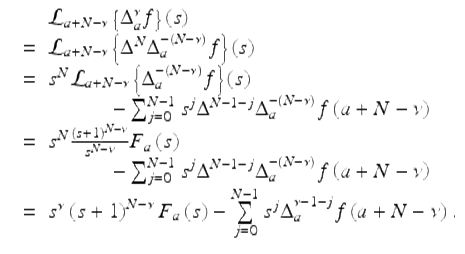Discrete Fractional Calculus (2015)
2. Discrete Delta Fractional Calculus and Laplace Transforms
2.8. The Laplace Transform of Fractional Operators
With Corollary 2.66 in hand to insure the correct domain of convergence for the Laplace transform of any fractional operator, we may now safely develop formulas for applying the Laplace transform to fractional operators. This is the content of the next theorem.
Theorem 2.67.
Suppose ![]() is of exponential order r ≥ 1, and let ν > 0 be given with N − 1 < ν ≤ N. Then for |s + 1| > r,
is of exponential order r ≥ 1, and let ν > 0 be given with N − 1 < ν ≤ N. Then for |s + 1| > r,

(2.49)
and

(2.50)
Proof.
Since ![]() is of exponential order r ≥ 1, F a (s) exists for | s + 1 | > r and by Corollary 2.66 both
is of exponential order r ≥ 1, F a (s) exists for | s + 1 | > r and by Corollary 2.66 both ![]() and
and ![]() exist for | s + 1 | > r. First, we find a relationship between the left-hand sides of equations (2.49) and (2.50). Using (2.37), we get
exist for | s + 1 | > r. First, we find a relationship between the left-hand sides of equations (2.49) and (2.50). Using (2.37), we get

(2.51)
using the fact that ![]() for 0 ≤ k ≤ N − 1, by our convention on sums.
for 0 ≤ k ≤ N − 1, by our convention on sums.
To see that (2.49) holds, note that

proving (2.49). Finally, using (2.51) and (2.49), we get

for | s + 1 | > r, proving (2.50). □
Example 2.68.
Find ![]() given that
given that
![]()
First note that
![]()
and hence using (2.39) we have that

for | s + 1 | > 1.
Then using (2.50) gives us

for | s + 1 | > 1.
Remark 2.69.
Note that when ν = N in (2.50), the correct well-known formula (2.46) for N = 1, is obtained. This holds true for the Laplace transform of a fractional difference as well, as the following theorem shows (Holm [123]).
Theorem 2.70.
Suppose ![]() is of exponential order r ≥ 1, and let ν > 0 be given with N − 1 < ν ≤ N. Then for |s + 1| > r
is of exponential order r ≥ 1, and let ν > 0 be given with N − 1 < ν ≤ N. Then for |s + 1| > r

(2.52)
Proof.
Let f, r, ν, and N be given as in the statement of the theorem. By Exercise 2.28 we have that (2.52) holds when ν = N. Hence we assume N − 1 < ν < N. To see this, consider

This completes the proof. □